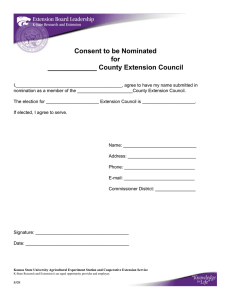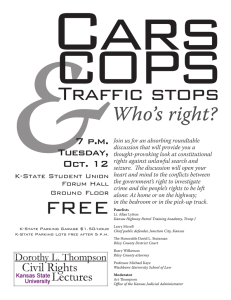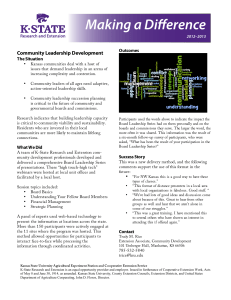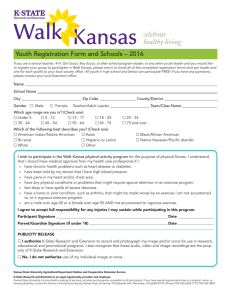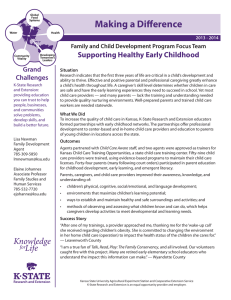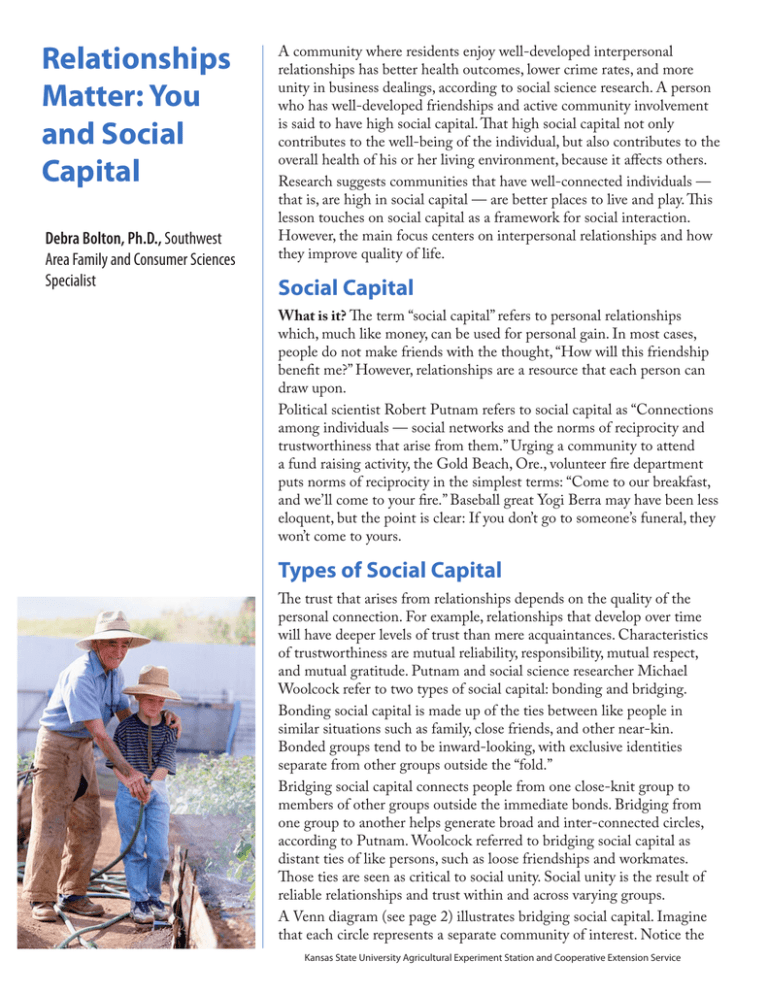
Relationships
Matter: You
and Social
Capital
Debra Bolton, Ph.D., Southwest
Area Family and Consumer Sciences
Specialist
A community where residents enjoy well-developed interpersonal
relationships has better health outcomes, lower crime rates, and more
unity in business dealings, according to social science research. A person
who has well-developed friendships and active community involvement
is said to have high social capital. That high social capital not only
contributes to the well-being of the individual, but also contributes to the
overall health of his or her living environment, because it affects others.
Research suggests communities that have well-connected individuals —
that is, are high in social capital — are better places to live and play. This
lesson touches on social capital as a framework for social interaction.
However, the main focus centers on interpersonal relationships and how
they improve quality of life.
Social Capital
What is it? The term “social capital” refers to personal relationships
which, much like money, can be used for personal gain. In most cases,
people do not make friends with the thought, “How will this friendship
benefit me?” However, relationships are a resource that each person can
draw upon.
Political scientist Robert Putnam refers to social capital as “Connections
among individuals — social networks and the norms of reciprocity and
trustworthiness that arise from them.” Urging a community to attend
a fund raising activity, the Gold Beach, Ore., volunteer fire department
puts norms of reciprocity in the simplest terms: “Come to our breakfast,
and we’ll come to your fire.” Baseball great Yogi Berra may have been less
eloquent, but the point is clear: If you don’t go to someone’s funeral, they
won’t come to yours.
Types of Social Capital
The trust that arises from relationships depends on the quality of the
personal connection. For example, relationships that develop over time
will have deeper levels of trust than mere acquaintances. Characteristics
of trustworthiness are mutual reliability, responsibility, mutual respect,
and mutual gratitude. Putnam and social science researcher Michael
Woolcock refer to two types of social capital: bonding and bridging.
Bonding social capital is made up of the ties between like people in
similar situations such as family, close friends, and other near-kin.
Bonded groups tend to be inward-looking, with exclusive identities
separate from other groups outside the “fold.”
Bridging social capital connects people from one close-knit group to
members of other groups outside the immediate bonds. Bridging from
one group to another helps generate broad and inter-connected circles,
according to Putnam. Woolcock referred to bridging social capital as
distant ties of like persons, such as loose friendships and workmates.
Those ties are seen as critical to social unity. Social unity is the result of
reliable relationships and trust within and across varying groups.
A Venn diagram (see page 2) illustrates bridging social capital. Imagine
that each circle represents a separate community of interest. Notice the
Kansas State University Agricultural Experiment Station and Cooperative Extension Service
intersection of the three circles. The intersection, triangular-like and
outlined in the diagram, represents where people from different groups
come together to exchange ideas and share resources.
Group 1
Relationships as Capital
Group 3
Group 2
How can people consider their relationships as a source of capital? Money
is financial capital that people use to buy food and pay mortgages. In other
words, money is exchanged for wants and needs. Like investing money for
later return, perhaps you can say you invest in your personal relationships
for later assistance. Of course, the immediate benefit of a relationship is
companionship and interacting with people of like minds. More personal
relationships mean more access to other networks and resources. Imagine
the benefit that would be for an elderly person living alone.
Remember, friends on social networking sites such as Facebook, for
example, usually are not seen as sources of social capital since those
“relationships” cannot be well-developed and often there are not
opportunities for building levels of trust.
Building Strong Relationships
Relationships matter. Where do you build your relationships? Possible
places are church, school, civic clubs, men’s or ladies’ clubs/societies, work,
neighborhood centers, or other places where people of like interests
gather. What do those relationships mean to you? Remember, building
interpersonal relationships does not have to be deliberate. Relationships
can be built anywhere. Some ties begin in a personal capacity and spill
over to professional alliances, while professional connections often turn
into long-term friendships. Relationships can be recognized as a public
good that generates positive outside connections, which, in turn, create
cooperation to reach common goals.
Measuring Social Capital
Since social capital is a vague concept, researchers look at the human
activities that tend to connect people to one another and that help
maintain social equality.
They may use gender, age, income, length of residency in a community,
education, marital status, and race/ethnicity to predict levels of social
interactions and community involvement. A questionnaire is provided on
page 4 as an example of a research instrument. Questions one through
seven, in this case, will be used to predict answers in the remaining
questions. These questions indicate levels of social connectedness and
community involvement. Persons with high social capital will likely
report many social contacts, will likely be actively engaged in the
community, will likely volunteer, and are most likely to have at least
a bachelor’s degree or be in a well-paying job earning a comfortable
living. Persons with high averages of social contacts and well-developed
relationships can report low incomes and less than a high school
diploma and still show wide ranges of connections and active community
involvement — that is, high social capital.
2
References
De Toqueville, A. (1832). Democracy in
America. Retrieved October 29, 2006.
http://xroads.virginia.edu/~HYPER/DETOC/
toc_indx.html.
Easterling, D., Foy, C. G., Fothergill, K.,
Leonard, L., & Holtgrave, D.R. (2007).
Assessing social capital in Kansas: Findings
from quantitative and qualitative studies.
A report to the Kansas Health Institute.
Retrieved January 27, 2010 , http://www.khi.
org/news/2007/nov/12/kansas-2006-socialcapital-report/?research.pdf
Field, J. (2003). Social capital. Routledge,
New York.
Flora, C.B., Flora, J. & Fey, S. (2004). Rural
Communities: Legacies and Change. 2nd Ed.
Westview Press, Boulder.
Islam, M.K., Merlo, J., Kawachi, I., Lindström,
M. & Gerdtham, U.G. (2006). Social capital
and health: Does egalitarianism matter? A
literature review. International Journal for
Equity in Health, 5(3), 3-117.
Narayan, D. (1999). Bonds and bridges: Social
capital and poverty. World Bank Poverty
Group, 1-51.
Putnam, R.D. (1993). The prosperous
community: Social capital and public life. The
American Prospect, 4 (13).
Putnam, R.D. (1995). Bowling Alone:
America’s declining social capital. Journal of
Democracy, 6, 65-78.
Putnam, R.D. (2000). Bowling Alone: the
collapse and revival of American community.
Simon and Schuster, New York.
Stull, Donald D. & Broadway, M. J. (2001).
“We come to the garden”…again: Garden
City, Kansas, 1990-2000. Urban Anthropology
& Cultural Systems & World Economic
Development, 30, 4, 269-331.
Woolcock, M. & Narayan, D. (2000). Social
capital: Implication for development theory,
research and policy. World Bank Research
Observer, 15(2), 1-15.
Woolcock, Michael. (1998). Social capital and
economic development: Toward a theoretical
synthesis and policy framework. Theory and
Society, 27 (2), 151-208.
Communities with stronger connections, more trusting relationships,
wider and denser networks, and more bridging across lines of difference
are in a better position to promote the well-being of their members.
Building Social Capital
Forget about building social capital but instead work on interpersonal
relationships. Most researchers do not view social capital as a deliberate
action that an individual attempts to achieve in order to elevate personal
status, contrary to Putnam’s idea that social relationships are more
purposeful. That may be truer in formal networks or associations such as
memberships in civic clubs, churches, and business organizations. You have
the choice to be deliberate about building social relationships. You could
join as many civic or social clubs as your time allows. What if you are not
a “joiner”? Look around you. What can you do for other people? Do you
volunteer? Do you offer your talents to people, organizations, or to your
community? The best way to build your relationships is not to think about
what other people can do for you, but what you can do for other people.
That is what builds relationships and networks, i.e., social capital.
Author
Debra J. Bolton, Ph.D., C.F.L.E., Family and Consumer Sciences
Specialist, K-State Research and Extension – Southwest Area
Reviewers
Charlotte Shoup Olsen, Ph.D., Family Systems Specialist, K-State
Research and Extension; Professor, School of Family Studies and Human
Services, Kansas State University
Sheryl Carson, Family and Consumer Sciences Agent, K-State Research
and Extension – Kearny County
Andrea Wood, Family and Consumer Sciences Agent, K-State Research
and Extension – Edwards County
3
Sample Social Capital Questionnaire
Social capital indicators are represented in this sample survey.
It gives examples of what researchers look at to measure this
somewhat vague concept. How do you fare?
1. How old are you? What is your gender?
9. How often in the past year have you spent time with your
friends at a park, store, restaurants, or other public places?
Both questions 8 and 9 help identify close relationships
that indicate “bonding social capital.”
Researchers ask these questions because age and gender
correlate with the quantity of social relationships. Women
tend to have more informal relationships, and men tend
to have more business connections. The older you are
correlates with higher social capital.
10. Do you feel that most people can be trusted?
2. How many years have you lived in this community?
12. In how many civic organizations or social clubs do you
participate?
The longer you live in one town or neighborhood, the
more likely that you will have high number of social
connections.
3. What is your marital status?
Researchers have correlated higher levels of social
connections and more community involvement with
being married as opposed to being single, divorced or
widowed.
4. What is your race/ethnicity?
This question is asked to understand the mix of people in
a community. Homogenous communities tend to report
more social connectedness and community involvement.
5. What is your current level of education?
11. Do you trust people from different racial backgrounds?
Questions 10 and 11 measure trusting relationships, which
are indicators of bridging social capital.
13. Do you attend or participate in any of the following
community activities? (Please check all that apply to you)
___Sport/recreation organizations/sports events
___Art or music organizations/activities
___Political parties
___Professional organizations
___Parades or other community celebrations
___County fair or rodeos
___School programs
Questions 12 and 13 measure for levels of community
involvement. The more involvement means wider access
to resources and new ideas.
Higher levels of formal education correlate to higher social 14. Do you attend a church?
capital.
15. Do you volunteer at a church, school, child care center, or
at other community organizations?
6. What is your current level of annual household income
before taxes?
16. How often do you donate money to any charities, church,
In many studies, social capital goes up as income
organizations, schools, or community projects?
increases. When questions about social connections that
Attending church, volunteering time, and giving money
contribute to survival, job finding, and kinship support
are all ways for you to build social connections, trust, and
are asked, we see that social capital is important to people
to increase community involvement.
living in poverty.
17. Do your trust law enforcement officials in your
7. Do you have close friends with whom you can confide?
community?
This is how researchers determine bonding social capital.
Trust of institutions is another indicator of general trust, a
mark of social capital.
8. How often in the past year have you either had friends to
your home or gone to others’ homes for activities?
Brand names appearing in this publication are for product identification purposes only.
No endorsement is intended, nor is criticism implied of similar products not mentioned.
Publications from Kansas State University are available at: www.ksre.ksu.edu
Publications are reviewed or revised annually by appropriate faculty to reflect current research and practice.
Date shown is that of publication or last revision. Contents of this publication may be freely reproduced for
educational purposes. All other rights reserved. In each case, credit Debra Bolton, Ph.D., C.F.L.E.,
Relationships Matter: You and Social Capital, Fact Sheet, Kansas State University, August 2011.
Kansas State University Agricultural Experiment Station and Cooperative Extension Service
MF2992
August 2011
K-State Research and Extension is an equal opportunity provider and employer. Issued in furtherance of Cooperative Extension Work, Acts of May 8 and June 30, 1914,
as amended. Kansas State University, County Extension Councils, Extension Districts, and United States Department of Agriculture Cooperating, Gary Pierzynski, Interim
Director.


